Order: Coraciiformes Family: Alcedinidae Conservation Status: Least Concern
Synonyms: White-breasted Kingfisher, Smyrna Kingfisher
Description:
The White-throated Kingfisher is a large kingfisher, measuring 28 cm in length. The adult bird has a bright turquoise-blue back, wings and tail. The head, shoulders, flanks and lower belly are chestnut-coloured whilst the throat and breast are white. The legs and large bill are bright red. In flight black wing tips can be seen and large white patches are visible on the wings.
There is little sexual dimorphism in adult birds, with the brown parts of the female appearing slightly lighter than those on the male.
Juvenile birds are overall duller versions of the adult, with a dark bill and fine dark scalloping on the breast.
Call and Vocalisation:
The call is described as a chuckling “chake-ake-ake-ake-ake”. White-throated Kingfishers are particularly noisy during the breeding season.
White-throated Kingfisher call 1
White-throated Kingfisher call 2
White-throated Kingfisher alarm call
Range and Distribution:
The White-throated Kingfisher is found across Eurasia, from Bulgaria and the Middle East, eastwards through South Asia, China and extending into South-East Asia, Whilst mostly sedentary, there is some evidence of small migratory movements and the range of the species does appear to be expanding.
There are six recognized sub-species which vary in size and also by the shades of colouration.
ssp. smyrnensis – Found in Middle East (Turkey, Northern and Central Israel, Egypt and Iraq) and eastwards through Pakistan, Afghanistan, north-western India
ssp. perpulchra – Found in Indochina, through the Malay Peninsula into western Java.
ssp. fusca – Found in Peninsular India and Sri Lanka.
ssp. fokiensis – Found in South China, Hong Kong, Taiwan and Hainan.
ssp. saturatior – Endemic to the Andaman Islands. This sub-species is larger than the nominate race and has darker brown underparts.
ssp. gularis – Found in the Philippines. This sub-species has only the neck and throat white
Habitat:
Within their range White-throated Kingfishers can be found across a wide variety of habitats, ranging from ponds, reservoirs, and coastal areas, through to forest edges, scrub, open woodlands and even parks, gardens and rural/suburban areas.
Diet:
The White-throated Kingfisher hunts small animals, such as rodents, frogs, snakes and fish as well as insects, worms and large crustaceans. They can sometimes be seen hovering in the air before plunging to catch prey. Hunting appears to be more successful for aquatic kills than those on dry land. White-throated Kingfishers are solitary hunters, however when food is in abundant supply they can be seen as close as 100 m to each other with no evidence of territorial disputes.
Breeding:
Breeding season for the White-throated Kingfisher is linked to the start of the monsoon season. In the early morning, male birds will perch on prominent high posts within their territory and call. The male courtship display consists of flicking of the tail and wings, exposing the white wing patches. The bill is also raised high to display their white throat markings. Some birds will perform a courtship flight, rising into the air before spiralling down again.
If the male is accepted the female will respond with a prolonged ‘kit-kit-kit’ call.
Both male and female will build a nest in an earth bank besides a road or stream. The birds start construction by flying into a suitable mud wall until a perch hold is created. A tunnel, usually 7 cm in diameter and between 50 and 100 cm in length, is burrowed using their large bills. At the end of the tunnel a breeding chamber, typically 20 cm in diameter, is constructed. A single clutch of 4 to 7 white round eggs is laid in this chamber. Both parents incubate the eggs for 20 to 22 days. After hatching both parents also care for the chicks which typically fledge after 19 days.
Conservation Status:
The White-throated Kingfisher is common throughout its range and has no major conservation threats. It has few natural predators, although there are records of Black Kites (Milvus migrans) and Jungle Crows (Corvus culminates) predating sick or injured birds.
In the 1800s these birds were hunted for their bright feathers that were used to adorn hats.

